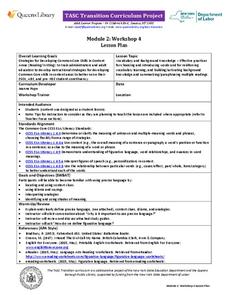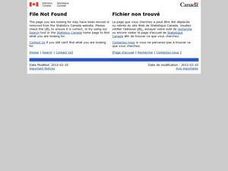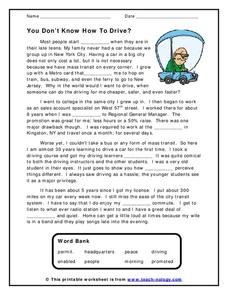Curated OER
Less vs. Fewer
When should you use less, and when should you use fewer? Straighten out this dilemma with a helpful resource about using less vs. fewer based on sentence context clues. After reading detailed instructions and examples, young learners...
Curated OER
Accent Marks & Special Characters in Spanish
Check out this clear description of how and when to use accent marks and special characters. The information, necessary to truly understand the purpose of special characters and accent marks would make a great reference material for...
Curated OER
Sound It Out
Unfortunately, the worksheet that is the focus of this lesson is not functioning properly. You can, however, use the Scholastic Children's Dictionary page attached to explore the dictionary with your elementary and middle schoolers. Talk...
New York State Education Department
TASC Transition Curriculum: Workshop 4
Why is it important to use precise language? Participants explore this question in the fourth activity in a series of 15 on effective instruction. Perfect for all content areas, the activity promotes appropriate language choice through...
Curated OER
Frederick Douglass, Narrative of the Life of Frederick Douglass an American Slave, Written by Himself
Foster reader confidence when encountering complex text and reinforce the skills readers have acquired to build and extend their understanding of text. The plan uses a section of Douglass’ narrative as an exemplar text. Directions for...
Curated OER
There's Omegas in Those Hemp Seeds
A very well-designed lesson plan focuses on the many benefits of Omega Fatty Acids. Learners read some articles on omega fatty acids, then access a glossary that is included in the plan. They fill in terms along with their definitions....
Curated OER
Where Were Your Ancestors in 1871?
Here is a nicely designed lesson on ancestry and family history. In it, learners read an article entitled, "Where Were Your Ancestors in 1871?" Then, they make up a series of questions to profile their family and their community 100...
Curated OER
Thanksgving Poem
First graders read a Thanksgiving poem to build reading comprehension skills. They develop the skill of using context clues while explaining the meaning of each line of the poem. The assessment is done as the teacher listens to poems...
Curated OER
Story Building: Nasreddin and the Beggar
In this story building worksheet, students build a story by choosing one of three sentences, using context clues to put the events of the story in order.
Curated OER
Nasreddin's Visitors: Recreating a Story
In this story recreation worksheet, students choose the correct sentence from 3 given to tell the story, using context clues to put the sentences in the proper sequence.
Curated OER
The Diary of Anne Frank
Eighth graders read the Diary of Anne Frank. In this novel reading lesson, 8th graders read and analyze the story. Students do online activities and create a newspaper giving a summary of three major events in the story. Students answer...
Curated OER
Finish the Sentences
In this recognizing sentence meaning and grammar worksheet, students read beginnings of sentences and write the endings. Students write 20 answers.
Curated OER
Mother's Day
In this Mother's Day worksheet, students read for information and assess comprehension and vocabulary skills. In this multiple choice worksheet, students answer ten questions.
Curated OER
Vocabulary Review
In this vocabulary review activity, students read for comprehension and complete conversations. Students choose words and phrases to complete eight sentences.
Curated OER
Homograph Exercises
In this recognizing meanings and usages of homophones/ homographs worksheet, students read sentences containing both homophones and a definition and underline the word in the sentence that matches the definition. Students identify 10...
Curated OER
Guided Reading With Fish Print
Students investigate the concept of reading comprehension using Fish Print. They practice reading skills with using picture clues, using context clues, and sight word recognition for simple sentences. The teacher guides the lesson with...
Teach-nology
You Don’t Know How to Drive?
A cloze reading passage about getting a driver's permit at an older age prompts kids to use context clues as they read. They can use the word bank below to fill in eight blank spaces throughout the story.
Curated OER
Reading Strategies: Those Darned Examinations
Eleventh graders demonstrate how to study for exams using Reciprocal Teaching technique. They apply new reading strategies when studying for an exam. They demonstrate a variety fo strategies before, during, and after reading to increase...
Curated OER
Tunes for Bears to Dance to: Vocabulary Strategy
To prepare for a reading of Robert Cormier's Tunes for Bears to Dance to, kids research vocabulary drawn from the novel and share their findings with their groups.
Curated OER
Predicting the Meaning of Unfamiliar Words in a Text
Middle schoolers develop strategies for what to do when they come upon words in a text that they don't know. After a class discussion, pupils are given a selection of text that contains some very difficult words. They are instructed to...
Simon & Schuster
Classroom Activities for The Call of the Wild by Jack London
Three activities are designed for readers of Jack London's The Call of the Wild. First, class members research and create posters that reflect the setting of the novel. Next, groups create posters with images that represent each chapter...
K20 LEARN
Things Are Lit at Thornfield: Jane Eyre
Jane Eyre offers scholars an opportunity to practice reading comprehension skills. Pairs are assigned a word from the text, use their prior knowledge, and consider the context, connotation, and denotation of the word to posit a...
Curated OER
Because of Winn-Dixie
Take an in-depth look at a passage from Kate DiCamillo's Because of Winn-Dixie. Included here is the reading passage as well as a step-by-step procedure for reading the text, a set of text-dependent questions, and a final writing...
CPALMS
Point of View: A Close Reading of Two Bad Ants
Chris Van Allsburg's Two Bad Ants provides third graders with an opportunity to examine point of view and how the point of view of others may differ from their own.

























